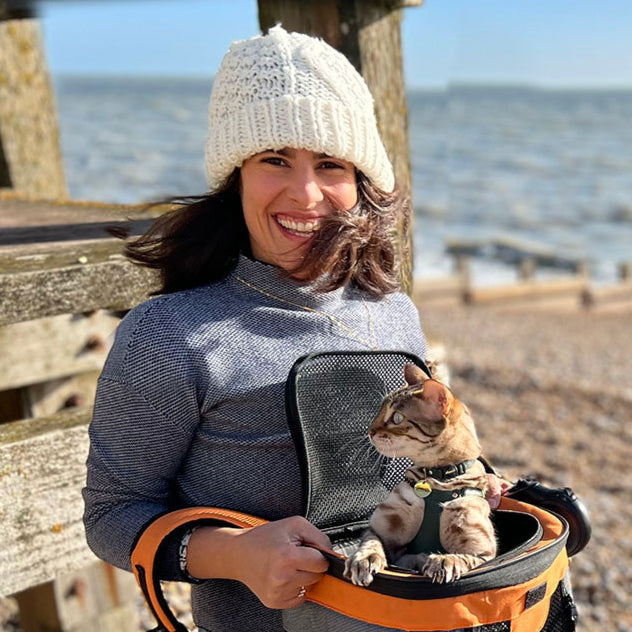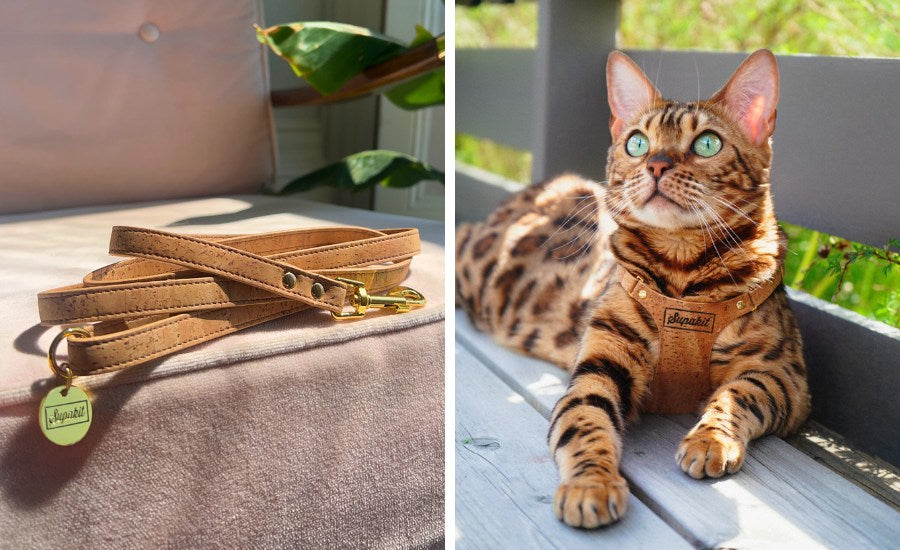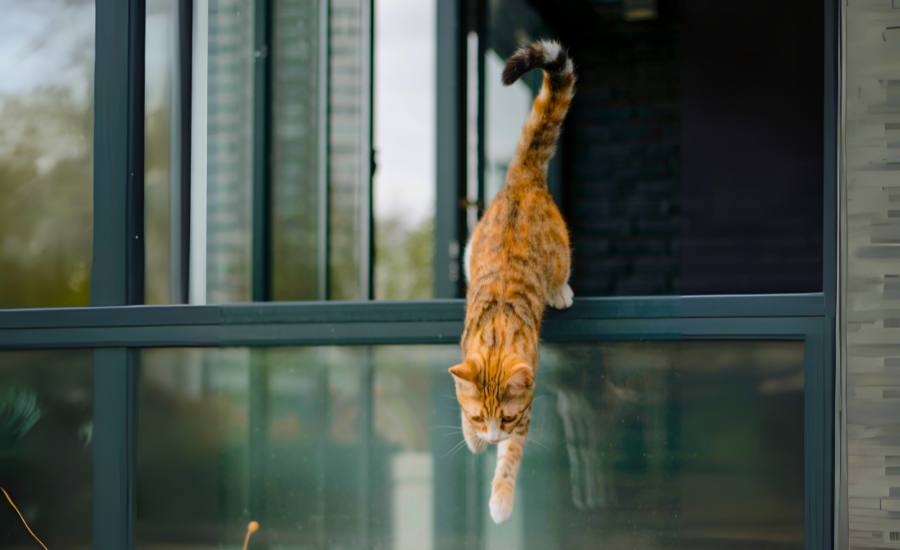8 Fun & Interesting Facts About Cat Behaviours
We know that our cats are clever – they have us wrapped firmly around their little, fluffy paws! But you might be surprised to know just how clever they are (1). It’s thought that they might even be smarter than toddlers, but they are often unwilling to participate in cognitive testing (that’s SO cat!).
So what are some of the surprising facts about cats? Here’s a run through of some of our faves...
Meow

Ok, we know what you’re thinking – a meow? It might seem like such a basic thing for a cat to do, but it is actually really surprising. Cats don’t meow to each other. The meow is something domesticated cats have learned to do, just to communicate with humans!
As kittens, the meow is used to communicate hunger to their mother but once a kitten has weaned and matured, there is no need for it to meow anymore (this is supported by studying feral cat populations, where adult cats seldom, if at all, meow at each other).
But your cunning kitty has kept their kitten-meow so that they can use it to talk to you! In fact, cats have gotten so good meowing that it’s believed they even change their tone and type of meow to ‘ask’ you for things. So, the next time your cat is hungry, listen and see if you can hear “feed me, human!”.
Tail talk

It turns out that meows aren’t the only way a cat can communicate! Your cat is a master of body language, so if you want to know how your cat is feeling, observing their tail position and movements can give you an amazing insight into what sort of mood they’re in!
Cat tails can move in a whole host of different ways – sometimes it’s almost as if they have a mind of their own! Study your cats tail movements and see what it tells you. Although each cat may tail talk in its own unique way, there are some trends in movement. Discontent kitties may move their tails from one side to another, whereas a cat who is ready to play (or hunt birds through the window) is more likely to flick and move their tail quickly. Slow, fluid tail swishes are commonly the sign of a relaxed or concentrating cat.
Get you know your cat’s own unique ‘tail talk’ by watching the various movements, in different situations and see what they are telling you!
Swim

Yes, that’s right! All cats are born with a natural ability to swim – it's an instinctive survival behaviour that they can do without any training at all. . However, this ability to swim doesn’t necessarily make them great swimmers. Like most things, it’s a skill that improves with practice.
But cats hate water – right? It’s a common belief, but not all cats dislike water. Cats can learn to enjoy playing with water and even like swimming, if they are given positive experiences with water from a young age. Many large cats, such as tigers and jaguars love water, but they are not the only ones. Some domestic cat breeds such as Turkish Vans, Bengals and Maine Coon are known to enjoy water too!
Walk on a leash

You may think this kind of behaviour is reserved solely for dogs, but your cat can learn to walk on a leash too! Harness and leash training has been used to help cats explore the outdoor safely and securely. Although cats are often deemed as ‘untrainable’, it’s simply not true. Cats have the ability to learn many skills, but unlocking their motivation to learn can be the tricky part! Cats are only likely to engage in activities that are rewarding and enjoyable to them.
So, if you want your kitty to strut their stuff on a harness and leash, make sure you embark on a training journey that is super fun and filled with lots of their fave treats and toys! Once your cat has learned that a leash means walks outside, they’ll be raring to go on adventures.
Give you a high-five

We’re serious! Just when you thought your cat couldn’t get any cooler.
Cats are capable of learning many skills and commands, high-five being one of them. Their high-intelligence levels make them capable of learning new skills throughout their lifetimes. However, their short attention spans mean that cats can lose interest in tasks or training rather quickly, so when teaching your cat a new skill, you should keep sessions short and fun!
But why would you want to train your cat to give you a high-five? It’s not just a party trick. There are many benefits to teaching your cat skills and commands.
For example, exercising your cat’s brain is just as important as exercising their body. Mental stimulation can help prevent unwanted behaviours caused by frustration or boredom.
Heal itself through purring

Are you picturing a witch with a black cat by her side? Well, maybe she wasn’t the only one capable of whipping up some magic! Scientists believe that cat purrs aren’t only incredibly cute but also capable of healing. The gentle rumble of a cat’s purr releases endorphins within the cat’s brain and the vibration frequency sits well within the range (20Hz-150Hz) known to promote bone healing, reduce swelling, ease pain and aid breathing (2). Some experts believe that cats can actually self-remedy before they even get a health issue.
The benefits of spending time with animals are better understood nowadays, from therapy animals to emotional support and service pets. But does a purr’s ‘healing powers’ have any effect on humans? Although your cat purr isn’t going to heal your broken leg, studies have shown that a cat’s purr can also release endorphins within humans (3), leading to a decrease stress levels, assisting with coping through an illness, and even lowering blood pressure. So, you want to live a longer, happier life? Just get a cat!
Always land on its feet

Ok, it’s not strictly true that cats always land on their feet, but they almost always do thanks to being born with a ‘righting reflex’. This is a cat's intrinsic ability to manoeuvre its body as it falls, twisting their super flexible spine, in order to land on all its paws!
A kitten’s righting reflex first starts to kicks in at around a month old. At this age they begin to show the ability to correct their body’s orientation when jumping and playing. It is believed that this incredible skill is perfected by around 7 weeks old.
Find its way home

If you have ever moved house with an outdoor cat, you may well have been told to put butter on its paws before you let it out. It’s commonly believed that not only does it help them survey their new environment, but they’ll use the little buttery paw trail to navigate their way home! We hate to break it to you, but cats will manage just fine without the butter…
Cats are some of the few animals that are recognised to have a homing-instinct or Psi-trailing (as its now known) (4) - an innate ability to navigate their way home. Some stories document how they have managed this over hundreds of miles. How your cat manages to do it though still remains a mystery to scientists! Theories include simple good memory, a combination of all of their senses, navigating territories and magnetic geolocation.
Bonus content: MORE fun & interesting facts
Cat Whiskers
Cat whiskers are super sensitive. They are rooted much deeper than a cat’s ordinary fur, and have a generous blood and nerve supply. What you might not know is that whiskers aren’t just on the nose! Look closely at your cat and you’ll see whiskers above their eyes, on their chin, and on the backs of their lower front legs.
Front Paws
We’re not going to argue about it – there is NOTHING cuter than watching your cat make biscuits. That kneading motion signifies that your kitty is content. But is there another reason your cat is kneading?
Yes! Cat’s have scent glands between their toes and often use their front paws to mark their territory. So, the next time your cat comes over and starts adorably kneading your lap, just know that they are leaving their scent - a mix of pheromones, undetectable by humans – to let other cats know that you belong to them! Oh, this is also why they insist on scratching up your sofa.
Extra Toes
Your kitty’s front paws have one ‘extra toe’ compared to their back. Honestly! Get counting – there are five on the front and four on the back. These extra claws are called ‘dewclaws’ and are kind of like thumbs.
It is common for mammals to have dewclaws but as the centuries have passed, the dewclaw, in most cases, has become redundant. Not in our cats! Domestic cats still use their dewclaw for hunting and playing, helping them get that extra grip on their 'prey'.
Catnip
Ok, we’re going to let you into a little secret – not all cats like catnip! In fact, only around half of cats respond to it. If you do have a cat that goes crazy for a sniff of catnip, the effects only last around 10 minutes, and you’ll need to wait around 2-3 hours for your cat to “reset”, before they go bonkers for catnip again.
Cat’s Nose
No two noses are the same! Your kitty has a unique ‘nose print’ which is unique to them, just like finger prints are to humans.
Lactose
Are you picturing a cartoon kitty lapping up a delicious bowl of milk? It may then come as a surprise to learn that cats (like most mammals) are lactose-intolerant. Lactose is a sugar found in dairy products and lactose-intolerance is the inability to digest this sugar. Giving your cat milk can cause it stomach discomfort so it is best to stick to water… preferably served from anything other than your cat’s water bowl, right?
Pouncing
Your cat’s eyes have locked on, they’re focused, they get low to the ground and… their butts begin to wiggle! This booty shake isn’t just amusing but it’s believed to serve a purpose. However the jury is still out on why cat’s wiggle their bottoms before they pounce – it’s a mystery! The theories vary but include; helping them to check their balance before pouncing; testing ground stability; a pre-pounce muscle warm up (think golfer before they swing) or simply a little indulgence in the joy of hunting. Whatever the reason, we’re so happy it’s part of the pounce process!
Conclusion
Just when we thought our amazing kitties couldn’t surprise us anymore, they do it again. We hope you loved these cat facts as much as we did!
References
- Jardim-Messeder, Débora, et al. "Dogs have the most neurons, though not the largest brain: trade-off between body mass and number of neurons in the cerebral cortex of large carnivoran species." Frontiers in neuroanatomy(2017): 118.
- Bicks, J., Why Do Cats Purr?
- Klotter, J., 2002. Vibrational frequencies that heal.(Shorts). Townsend Letter for Doctors and Patients, (226), pp.28-29.
- Lincoln, F.C., 1934. The operation of homing instinct. Bird-Banding, 5(4), pp.149-155.
- Rhine, J.B., 1952. The problem of psi-missing. The Journal of Parapsychology, 16(2), p.90.







